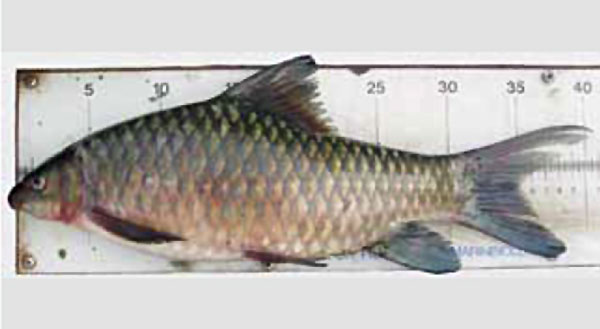| Cyprinidae (Minnows or carps), subfamily: Torinae |
| 24.5 cm SL (male/unsexed) |
|
benthopelagic; freshwater |
| Africa: many coastal basins of West Africa, from the Konkouré River in Guinea to the west of the Volta (Ref. 2940, 81282). |
|
Dorsal soft rays (total): 13-16; Anal soft rays: 8-8. Diagnosis: last simple ray partly ossified at base (no strong spine) and distinctly longer than head; lower reduced, substituted by horny sheath; 9-12 (usually 10) dorsal fin branched rays; scale formula 3.5-4.5/23-29/3.5-4.5; 2 scales between lateral line and pelvic-fin base; 12 scales around caudal peduncle (Ref. 2940, 81282).
Description: mouth inferior and broad; barbels very short, especially the anterior part; posterior barbels only 7-15% of head length; scales with striae converging posteriorly; dorsal fin long, with last simple ray ossified at base and as long as head in juveniles, but distinctly longer in adults; D:IV,9-12; A:III,5; P:I,14-16; V:I,8 (Ref. 2940, 81282).
Coloration: uniformly greyish black to greenish, lighter on belly; fins usually dark grey; young individuals with marbling on sides (Ref. 2940, 81282). |
| Barbus wurtzi has differences in meristic and morphometric characteristics depending on which population; body depth varies between 26-33% in Guinean rivers and 34-43% in the Cavally and Nipoué rivers; the caudal peduncle length-height ratio is approximately 100% in Cavally-Nipoue and reaches an average of 140% in Guinean rivers; population east of Ivory Coast has intermediary characteristics such as number of scales above and below the lateral line: 4.5 in Guinea and Ivory Coast, 3.5 in western part of Ivory Coast and east of Liberia (Ref. 2940). Maximum TL was recorded at 27.5 cm (Ref. 2801). |
|
Least Concern (LC); Date assessed: 15 January 2020 Ref. (130435)
|
| harmless |
Source and more info: www.fishbase.org. For personal, classroom, and other internal use only. Not for publication.
